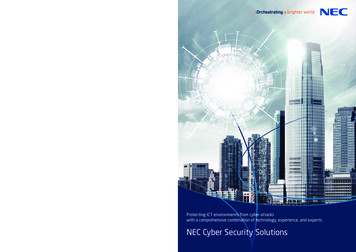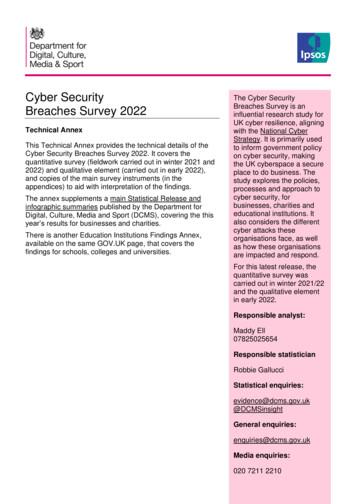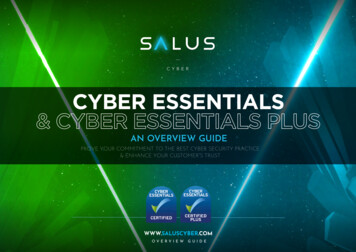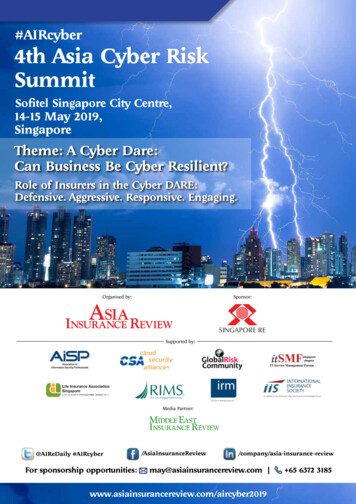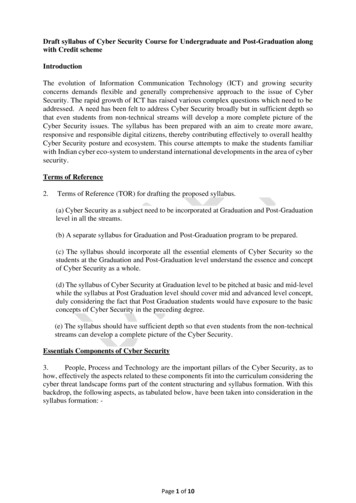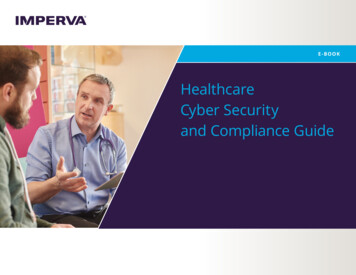
Transcription
E-BOOKHealthcareCyber Securityand Compliance Guide
ContentHealth Care Security and Cybercrime. 3What Really Matters. 4Defend Against DDoS Attacks. 6Web Application Security. 8Safeguard Sensistive Data. 9Detect Insider Threats. 11Streamline Audit and Compliance. 13Database Security Compliance. 14File Security Compliance. 15Web Application Security Compliance. 16Industry Leading Cyber Security. 17Our Solution. 182 Healthcare Cyber Security and Compliance Guide
IntroductionHealthcare Security and CybercrimeFor Health Carethe cost of a securitybreach has leptThe healthcare industry is quickly growing as a sweet-spot for hackers to steal large amountsof patient records for profit. The US Department of Health and Human Services websitereveals that in 2015, over 111 million individuals’ data was lost due to hacking or IT incidentsin the US alone1. Furthermore, security incidents have soared 60 percent and the cost of asecurity breach leapt 282 percent in healthcare2. Hospitals are known to be a soft target,thus making it easy for hackers to gather large amounts of patient data in a single hackingeffort. As cyberattacks and Internet threats continue to rise with the use of web-basedhealthcare portals and remote patient mobile technology, managing security andcompliance across a distributed healthcare organization becomes a daunting task.282%123 Healthcare Cyber Security and Compliance GuideBreach Portal: Notice to the Secretary of HHS Breach of Unsecured Protected Health Information”“Why Healthcare Security Matters”, 22 July 2015, SecurityWeek
What Really MattersWhat Really Matters–Securing The DataUltimately, hackers are motivated to steal patient healthcare recordsfor profit. According to Reuters, a single stolen healthcare credentialis worth 10 when sold on the black market, which is 10-to-20 timesmore valuable than a single stolen credit card3. Unlike stolen financialcredit card data, healthcare data can be used to impersonate a person,to receive free healthcare, or file fraudulent claims. A typical healthcarepatient record includes name, address, social security number, birthdate and health history. With such a wide amount of personal data,a thief can open credit accounts or apply for medical care. While,a person’s financial identity can be fully restored, healthcare databreaches have a much more personal and longer-lasting impactupon victims.Cybercriminals use a variety of methods to profit from the healthcareindustry. But, in the end, their ability to monetize is predicated uponeither disrupting operations or stealing data.3“Your medical record is worth more to hackers than your credit card”,24 Sept 2014, Reuters4 Healthcare Cyber Security and Compliance GuideA single stolen healthcare credentialis worth 10-to-20 times more than asingle stolen credit card
What Really MattersBelow are key areas of healthcare security that are directly addressed by Imperva cyber security solutions:Denial of ServiceWeb ApplicationDataInsiderRegulatory(DDoS) ProtectionSecuritySecurityThreatsComplianceU S E C ASEBEN EFITDenial of Service (DDoS) ProtectionShield critical online assets from a wide range ofDDoS attacks with an always-on, scalable serviceWeb Application SecurityProtect online patient portals and Internet-connectedmedical technologies from account takeover and vulnerability exploitsData SecurityIdentify security violations and protect data at the sourceInsider ThreatsDetect and mitigate data abuse by malicious, carelessand compromised insidersRegulatory ComplianceMeet compliance and audit mandates for HIPAA, PCI,and FDA; automate reporting5 Healthcare Cyber Security and Compliance Guide
Defend Against DDoS AttacksDefend Against Denial-of-Service Attacks (DDoS)DDoS attacks are designed to compromise the availability of healthcare patient portals and client websites. These attacks cause slow websiteresponse times and prevent customers from accessing an institution’s public website. As healthcare organizations continue to build their onlinepresence and adopt Internet connected medical technologies and online exchanges, DDoS attacks will continue to be of major concern. DDoSattacks are a top concern in 2016 along with ransomware and malware as the top three cyber threats facing healthcare organizations kDDos Sixth Annual Benchmark Study on Privacy & Security of Healthcare Data, May 2016, Ponemon Institute46 Healthcare Cyber Security and Compliance GuideYour Servers
Defend Against DDoS AttacksWhile a primary motivation of DDoS attacks is extortion, they also serve as a diversionarytactic for criminals attempting to steal money or healthcare data. DDoS attacks result inbusiness disruption, reputation damage, lost revenue and reduced customer confidence.Application layer attacksgrowing more advancedThe percentage of bots knowhow to pass standard securitychallenges grew 6x from lastquarter to almost 37%5Network layerattacks are becomingmore sophisticated1 out of 3 networklayer attacks combinedhigh bandwidth andhigh packet rates55Imperva Incapula Q3 2015 DDoS Report7 Healthcare Cyber Security and Compliance GuideTake for example, the recent hackers purportedly representing the hacktivist groupAnonymous, who hit Boston Children’s Hospital with phishing and DDoS in protest of thecontroversial custody case of Justina Pelletier, who was being kept a patient at BostonChildren’s Hospital as a ward of the state against the wishes of her parents. This DDoS attacktargeted the hospital’s servers and hampered hospital operations for a week.Imperva helps healthcare organizations shield critical onlineassets against DDoS attacks by: Protecting against a wide-range of DDoS attacks includinglayer 3/4 volumetric attacks, low and slow attacks, and layer 7 application attacks. Scaling bandwidth on-demand to absorb peak attack traffic which can be10-to-100 times greater than standard Internet traffic levels. Monitoring application and network traffic to detect and stop malicious usersand requests.
Web Application SecurityWeb Application SecurityThe rapid digitizationof consumers’ lives andenterprise records willincrease the cost thatbreached organizations willpay for data breaches to 2.1 trillion globallyby 2019.6JUNIPER RESEARCHOnline patient portals, health information exchanges (HIE), and cloud applications areconsidered prime targets for cyber criminals because they can provide direct access tosensitive data inside a healthcare organization. Juniper Research suggests that the rapiddigitization of consumers’ lives and enterprise records will increase the cost that breachedorganizations will pay for data breaches to 2.1 trillion globally by 20195. Internet accessiblepatient portals and HIEs are compromised using two distinct types of attack vectors: accesscontrol attacks and application vulnerabilities.Access control attacks involve the use of stolen credentials to gain unauthorized access tocustomer accounts. Account takeover is usually the first step to committing fraud. Once criminalshave successfully hijacked a customer’s bank account, they can commit fraudulent transactionsor steal personally identifiable information (PII) to enable fraud.Cyber criminals also exploit application vulnerabilities. Many online and mobile healthcareapplications are custom-developed applications created by an in-house applicationdevelopment team or third-party developers. When vulnerabilities are found in theseapplications, it can take months to develop, test and implement code fixes. That also leavesthe web application exposed to attackers for months.The following Imperva solutions helps healthcare organizations protect against web attacks: Imperva SecureSphere Web Application Firewall (WAF) defends against a wide range ofweb application attacks including account access control and technical attacks like SQLinjections. Implementing a WAF also enables healthcare organizations to virtually patchapplication vulnerabilities to reduce the exposure time from months to days. Imperva Threat Radar global threat intelligence improves detection accuracy and securityoperations by identifying new attack vectors and blocking known malicious sources. “Cybercrime will cost businesses over 2 trillion by 2019’, 12 May 2015, Juniper Research68 Healthcare Cyber Security and Compliance Guide
Safeguard Sensitive DataSafeguard Sensitive DataGiven the vast amounts of data healthcare organizations collect and process, data security should be a top priority. In a well-publicized 2015healthcare breach, hackers gained access to 80 million records that contained personal information on current and former members, the largestcyber attack ever disclosed by a healthcare provider.7Many organizations have implemented perimeter security, data loss prevention, intrusion prevention/detection systems and endpoint protection,but healthcare organizations’ complex IT environments adds new data security requirements to protect data at the source. Multiple relational andnon-relational data stores, instances and versions (often from different vendors), and geographically distributed systems that require coordinatedpolicies, monitoring and enforcement leave gaps between systems and applications, leaving these data stores vulnerable to attack.Furthermore, cyber criminals employ multi-stage attacks, leveraging compromised credentials, obtained via malware and phishing campaigns, toinfiltrate the secure perimeter. Once inside, they look for privileged user accounts to elevate their access privileges and move laterally until theyfind the data they’re after. Proactive security monitoring deployed at the data level is the last opportunity to stop an in-progress data attack. “Hackers breach Anthem; 80m exposed”, 4 February 2015, Modern Healthcare79 Healthcare Cyber Security and Compliance Guide
Safeguard Sensitive DataImperva helps health-care organizations safeguard data by: Discovering where sensitive data lives—in the cloud and on-premises. The first step in protecting data is knowing where an organization’ssensitive data is. Automated discovery and classification are the only reliable way to routinely and consistently discover and classify newor modified database instances containing sensitive data. Monitoring data usage activity across a broad range of data stores. While databases are a prime target for criminals, sensitive data exists inmany types of systems–databases, Big Data platforms, SharePoint portals and file stores. And this data lives both in the cloud and on-premises. Managing user access. Attackers look for easy opportunities to access sensitive data. They target privileged user accounts, users with excessiveaccess rights and dormant user accounts. To limit lateral movement of attackers and reduce the risk of data breach, healthcare organizationsmust proactively monitor privileged users, identify users who have excessive privileges and deactivate dormant user accounts. Masking data in non-production environments. Data masking reduces the attack surface by eliminating sensitive data in non-productionenvironments. Rather than creating copies of sensitive data for test and development teams or for market research purposes, healthcareorganizations can enable these groups by replacing sensitive data with realistic, fictional data.DiscoverSensitive Data10 Healthcare Cyber Security and Compliance GuideMonitorData UsageManageUser AccessMaskData
Detect Insider ThreatsDetect Insider ThreatsInside jobs have been around for as long as business has existedand insider threats continue to be a major security concern fortoday’s healthcare organizations. 92% of healthcare IT decisionmakers reported that their organizations are vulnerable to insiderthreats, and 49% felt extremely vulnerable.8Whether they’re motivated by monetary gain or damaging acompany’s reputation, these individuals are already inside yourperimeter defenses. They are employees, contractors and partnersthat have legitimate access to your valuable data. While themalicious insiders get most of the limelight, it’s critical to keep inmind that insider threats extend beyond the disgruntled employeeand include compromised and careless users. According to theVerizon DBIR, 76% of data breaches involve stolen or exploited useraccounts9. That’s why insider threats are one of the most difficultto detect. 2015 Vormetric Insider Threat Report, Vormetric, May 20158 “Verizon Data-Breach Investigation Report (DBIR), May 2013, Verizon911 Healthcare Cyber Security and Compliance Guide92%of HealthcareIT decision-makers reported thattheir organizations arevulnerable to insider threats.8
Detect Insider ThreatsNo discussion of insider threats would be complete without lookingat privileged user access. Privileged users are perhaps the biggestrisk when it comes to insider threats. The very nature of their rolesand the often unfettered access to critical systems and sensitive data,make system administrators and DBAs prime targets for attackers.Compromising privileged user credentials essentially gives criminalsthe keys to the kingdom.To detect and contain insider threats, Imperva enables healthcareorganizations to: Gain visibility into who is accessing data. While many healthcareorganizations trust their employees, they must also verify that trustis well placed. Real-time monitoring of all user access, includingprivileged user access, to databases and files on premises or in thecloud gives IT visibility into which users are accessing what data. Analyze user behavior. Establishing a baseline of “normal” userpatterns via big data, dynamic profiling, machine learning and peergroup analytics allows IT to identify anomalous data access. Forexample, a DBA typically accesses database A between the hoursof 9 a.m. to 5 p.m., and then suddenly starts accessing database Xbetween 2 a.m. and 4 a.m. In this scenario, user behavior analyticswould detect and prioritize this anomalous data access. Monitor privileged user access: Proactive monitoring of all privilegedaccess to databases, files and cloud applications helps healthcareorganizations keep a watchful eye on system administrators andDBAs and protect critical IT assets from advanced cyber attacks. Eliminate excessive access rights: Healthcare organizations canreduce the risk of insider theft by granting access to sensitive dataon a business need-to-know basis. Mask data in non-production environments. Data masking reducesthe unnecessary spread of sensitive data and enables organizationsto implement least privilege by replacing sensitive data with realistic,fictional data.12 Healthcare Cyber Security and Compliance Guide
Streamline Audit and ComplianceStreamline Audit and ComplianceRegulatory and industry compliance are major drivers of security investment for healthcareorganizations. While compliance is certainly not security, compliance can provide a solid foundationfor an information security program. After all, many of the data protection and privacy mandates areintended to protect consumers by ensuring proper security controls are implemented.While complianceis certainly not security,compliance can providea solid foundationfor an informationsecurity programCompliance remains a daunting challenge for healthcare organizations. Security requirementsare found within a broad set of regulations and mandates, including HIPAA and PCI. Healthcareorganizations require automated, continuous compliance across ever-changing regulations anda dynamic IT environment.Imperva provides industry cyber security leading solutions that help healthcare organizationsstreamline database audit and compliance.Imperva has powerful centralized management and reporting solutions that unify security operationsto simplify distributed management. Imperva solutions support environments ranging from a singlelocation to those with multiple lines-of-business, geographic locations or data centers.Advanced web application, database security, and file server security products that offer a widerange of features comprise the suite of Imperva cyber security solutions that protect healthcareorganizations. Imperva secures sensitive patient data in three key areas: data security, insider threats,and web applications.13 Healthcare Cyber Security and Compliance Guide
Streamline Audit and Compliance - Database SecurityR EQUI RE M E N TRE GULATIONSIMPERVA CAPABILITIESDatabase SecurityHIPAA 164.308 (a)(5) Login Monitoring;164.312 (a)(1) Access ControlDatabase Activity MonitorPCI 10 Security Logging and Monitoring Alert and block unauthorized accessHIPAA 164.308 (a)(1) Protection frommalicious software; HIPAA 164.312( c)(1) IntegrityDatabase AssessmentPCI 6 Maintain VulnerabilityAssessment Program Discover newly created databases and database objects holding ePHIHIPAA 164.312(a)(1) Access ControlUser Rights Management for DatabasesPCI 7 for Access controlAddresses; PCI 8.5 for InactiveUser AccountsHIPAA 164.312 (a)(1) Access ControlHIPAA 164.308 (a)(5) InformationAccess ManagementPCI 7 Restrict AccessPCI 8.5 Implement Strong Access control14 Healthcare Cyber Security and Compliance Guide Audit all access to patient data in databases Login event logging and monitoring Assess database vulnerabilities Discover and Identify database objects housing patient data Identify users with excessive rights Support database user rights reviewCounterBreach Consolidated view analyzes user access behavior across database, file, and cloud application data Establish a baseline of typical user access to database tables and file shares Detects and prioritizes anomalous activity
Streamline Audit and Compliance - File SecurityR EQUI RE M E N TRE GULATIONSIMPERVA CAPABILITIESFile SecurityHIPAA 164.308 (a)(5) Log-In MonitoringFile Activity MonitorHIPAA 164.312 (a)(1) Access ControlPCI 10 Track and monitor access Security Logging and Monitoring File Integrity Monitoring Audit access to patient medical records stored in files and spreadsheetsPCI 11.5 File Integrity Monitoring Offers tamper-proof audit trailHIPAA 164.312 (a)(1) Access ControlUser Rights Management for FilesHIPAA 164.308 (a)(5)PCI 7Access Control Alert and block unauthorized access of patient data Access-Control Inactive User Accounts Identify users with excessive rightsPCI 8.5 Inactive User Accounts Support user rights review and approval processesHIPAA 164.312 (a)(1) Access ControlCounterBreachPCI 10 Track and monitor access Automate reporting on user rights access to patient data Consolidated view analyzes user access behavior across database, file, and cloud application data Establish a baseline of typical user access to database tables and file shares Detects and prioritizes anomalous activity15 Healthcare Cyber Security and Compliance Guide
Streamline Audit and Compliance - Web Application SecurityR EQUI RE M E N TRE GULATIONSIMPERVA CAPABILITIESWeb ApplicationSecurityHIPAA 164.308 (a)(4) InformationAccess ManagementWeb Application FirewallHIPAA 164.312 (c)(1) Integrity Controls Protection against zero-day application and OWASP Top 10 attacksPCI 6.6 Vulnerability ManagementHIPAA 164.312 (c)(1) Integrity ControlsPCI 6.6 Vulnerability Management Web Application security Integration with code-scanner for vulnerability management Virtual patching for web applicationsSkyfence Enforce controls on sanctioned and unsanctioned cloud applications Assess risks of cloud applications, pinpoint compliance gaps, and protect user accounts and data in the cloud Monitor and analyze data usage, administrator activity, and API activity while preventing account-centric threatsHIPAA 164.312 (c)(1) Integrity ControlsPCI 6.6 Vulnerability ManagementIncapsula Cloud-based application delivery service that protects websites while increasing performance Guards web applications against from OWASP top 10 web attacks like SQL injection and XSS Includes web application firewall to thwart hacking attempts, DDoS attacks, and web traffic acceleration PCI-certified cloud application delivery service meets PCI 6.6 mandate for web application firewall requirementsThreatRadar Crowd-Sourced threat intelligence aggregates attack data from third-party security leaders and Imperva SecureSphereWAF customers worldwide Increases detection and protection of web applications by quickly identifying new attack vectors and blockingmalicious sources Streamlines security operations by automatically blocking web requests based on user reputation, botnets, accounttakeover attempts, and reconnaissance.16 Healthcare Cyber Security and Compliance Guide
Industry Leadingn Cyber SecurityImperva Provides Industry Leading Cyber SecuritySolutions to HealthcareImperva is a leading provider of cyber security solutions that protectbusiness-critical data and applications in the cloud and on-premises.Healthcare organizations around the world rely on our solutions andexperience to protect their data and applications.Our cyber security solutions enable healthcare organizations to discoverassets and risks, then protect their most valuable information–customerpatient records, accounts and transactions and financial records. Wealso help healthcare organizations comply with the myriad of stringentdata protection regulations and mandates, as well as enforce policies,entitlements and audit controls.17 Healthcare Cyber Security and Compliance Guide
Our SolutionSaaSActivity MonitorThreatBlockedSaaS Imperva SkyfenceDatabaseActivity MonitorWeb Applicationand InfrastructureSecurityApplicationsThreatBlocked Imperva SecureSphereDatabase Activity MonitorFile ActivityMonitorInternetThreats Imperva SecureSphereWeb Application Firewall Imperva ThreatRadar Imperva IncapsulaThreatBlockedData BasePatient DataThreatBlocked Imperva SecureSphereFile Activity MonitorFile ServerInsiderThreats Imperva CounterBreachOur solutions include: Imperva SecureSphere: a comprehensive cyber security platformthat includes web, database and file security Imperva CounterBreach: a multi-layered security solutionthat protects enterprise data from theft and loss caused bycompromised,careless and malicious users Imperva ThreatRadar: an advanced warning system that stopsemerging threats before they impact your business18 Healthcare Cyber Security and Compliance Guide Imperva Camouflage: a data masking solution that reduces riskexposure by replacing sensitive data with realistic fictional data Imperva Incapsula: a cloud-based application delivery service thatprotects websites and accelerates their performance for thebest possible user experience Imperva Skyfence: a cloud access security broker (CASB) thatprovides visibility and control over sanctioned and unsanctionedcould appsFor more information,, please visit www.imperva.com/go/healthcare
2016, Imperva, Inc. All rights reserved. Imperva, the Imperva logo, SecureSphere, Incapsula, ThreatRadar,Skyfence and CounterBreach are trademarks of Imperva, Inc. and its subsidiaries. All other brand or productnames are trademarks or registered trademarks of their respective holders. eBook-Healthcare-0716-rev1imperva.com
5 Healthcare Cyber Security and Compliance Guide What Really Matters Below are key areas of healthcare security that are directly addressed by Imperva cyber security solutions: USE CASE BENEFIT Denial of Service (DDoS) Protection Shield critical online assets from a wide range of DDoS attacks with an always-on, scalable service Web Application .



